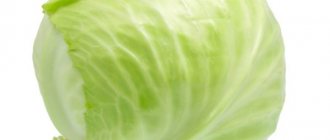Megaton F1 cabbage is very popular among gardeners. Because vegetables grown in your own garden have always been considered environmentally friendly. When growing this vegetable crop, the use of chemicals is required to help control pests. And also a lot of different fertilizers. It is not surprising that they prefer to grow the Megaton cabbage variety on their own.
A very important point for a gardener is the choice of varieties. Because the volume of the harvest depends on it. As well as resistance to various diseases. The white cabbage variety Megaton is distinguished by its resistance to disease. And it always gives high yields. He is not demanding. And therefore, even a novice gardener will find it easy to care for.
Cabbage Megaton F1: history of creation
Cabbage Megaton f1: photo of the variety
The cabbage variety Megaton appeared thanks to a group of breeding scientists from Holland. They worked for the seed company Bejo Zaden. They managed to create a white cabbage that satisfies the needs of most people involved in agricultural activities.
The cabbage variety Megaton f1 always produces harvests of large, elastic heads of cabbage. They have high immunity to various diseases. And also to harmful insects. They tolerate bad weather conditions well. They have medium ripening periods. They are perfectly stored, retaining all their qualities for a long time.
In the Russian Federation, the Megaton cabbage variety began to be grown in the late 90s. As soon as it was included in the State Register. And it quickly began to gain popularity. However, in some regions of our country, such as the Republic of Mordovia, Tatarstan, Penza region, Samara region, Ulyanovsk region, growing this variety is not recommended.
As for the rest of the territory, gardeners here give the highest marks to Dutch breeders for creating the Megaton cabbage variety.
Advantages and disadvantages
Among the advantages of this variety are the following:
- Great taste. The cabbage is juicy and crispy, very tasty when pickled.
- High yield.
- Good immunity to crop diseases, especially fusarium, gray rot and clubroot.
- Resistant to weather changes.
- Withstands long-distance transportation well.
Among the disadvantages of this hybrid are the following:
- Hard leaves for the first few days after cutting.
- A large amount of sugar, which is why cabbage is not suitable for making salads and cabbage rolls.
- Short shelf life, according to some gardeners.
Cabbage Megaton F1: variety description and characteristics
Cabbage Megaton: photo of the variety
When choosing planting material, it is important to pay attention to the characteristics. As well as the necessary growing conditions for this variety. All the little things are important. Therefore, you should not underestimate them. Megaton cabbage is a medium-ripening variety. Harvests can be harvested 5 months after the seeds are planted.
The leaves of the cabbage variety Megaton have large rosettes. They are raised or placed horizontally. The rounded leaves are wavy and concave at the edges. Light green matte color. The forks are large and round in shape. And also a dense structure. When fully ripe, this vegetable crop is very hard.
Megaton cabbage fruits are formed on a 15-centimeter stalk located inside. Their weight is usually about 4 kilograms. However, with a little experience and knowledge regarding care, you can get fruits up to 15 kilograms. The inside of the cabbage is white as snow.
Megaton f1 cabbage contains a huge amount of useful vitamins. As well as microelements that have a positive effect on human health and life. In 100 gr. The product contains about 3% protein, about 40% vitamin C. And also no more than 5% sugars and about 8% dry matter.
Cabbage Megaton F1: planting a variety
Having decided on the variety and choosing the Megaton cabbage variety among all the others, go to a specialized store to purchase it. Or a nursery. Because by purchasing seeds there, you can be calm about the quality. As well as seed germination. Considering that the seeds are not cheap, this fact is important. Packages of seeds purchased in a store will most likely give seed germination rates of 10 out of 10.
After purchasing Megaton cabbage seeds, you can start sowing them. But only for seedlings. Because this variety is suitable only for the seedling method of cultivation. Taking into account the fact that Megaton cabbage is a medium-ripening variety, seeds should be sown between mid-April and mid-May.
Preparing Megaton cabbage seeds for planting
In order for healthy Megaton cabbage seedlings to grow and ultimately produce beautiful dense heads of cabbage, the seeds need special preparation.
So, in order to do this, we need:
- Heat the water to 50 degrees. Place the seeds there for 20 minutes, wrapping them in a bag made of any fabric. Then transfer to chilled water.
- Soak the seeds in a solution of Epin, Nitrophoska or Zircon. Leave for a couple of hours. Next, the seeds should be rinsed well in running water. And also dry it.
- Hardening of the seed within 72 hours before planting. To do this, you need to put them on the bottom shelf in the refrigerator. This will help increase resistance to cold weather.
It should be noted that growing seedlings helps to increase the yield in cabbage beds. It also promotes faster ripening of heads of cabbage.
Cabbage Megaton F1: sowing seeds
Before sowing, you need to fill the containers with fertile soil, adding wood ash. Next, you need to dissolve a small amount of potassium permanganate in boiling water. And pour this hot solution over the soil. After the water is absorbed and the soil temperature drops to room temperature, furrows should be made at a distance of 7 centimeters. Megaton cabbage seeds are placed 3 centimeters deep. With a distance of at least 3 centimeters from each other. If you do not plan to pick seedlings, then this period should be increased. Next, the container is covered with film to speed up germination. And it is exposed on the street.
After 4 days, shoots appear. There is no need to remove the film. Because it is necessary to keep warm. If the weather is hot outside, the film rises so that the plant can receive enough air. And it didn’t suffocate.
Note! Megaton cabbage seedlings should be in an open, sunny place. Because it needs a lot of light for a long time.
Seedling care
During the entire period of growth of young seedlings, they must be regularly watered with water at room temperature. And also remove weeds. Wood ash works well against the cruciferous flea beetle, repelling it. It also saturates the soil with useful substances. Therefore, it would not be a bad idea to sprinkle the young plant with it.
If you decide to plant plants in separate containers, you should wait until 2 or 3 leaves form. Cabbage loves fertile soils treated with boiling water.
As soon as the Megaton cabbage seedling is removed from the general container, its root is cut off by 1/3. Then they are placed in separate containers. Covered with film. Or they go to the greenhouse. It is important that the plant receives a lot of light. And also not subject to night frosts.
During the first weeks, special attention should be paid to Megaton cabbage seedlings. What does this mean: moderate watering, removal of weeds. As well as loosening the soil. Because the formation of the future harvest depends on the initial care. After all, only a strong and healthy plant can bring good yields of high-quality heads of cabbage.
Transplanting Megaton cabbage seedlings into the garden
Transplanting Megaton cabbage seedlings into open ground should occur when the plant is at least 15 centimeters in height, its stem is thick enough and there are at least 4 leaves on it.
Planting usually takes place in the last week of May, but it should be remembered that the dates may be shifted taking into account the region where the vegetable crop will be grown.
It is important to know! By planting strong seedlings in open ground, they will be able to withstand frosts down to -3 degrees.
Preparing the soil for the upcoming cultivation of the Megaton cabbage variety takes place in the fall. It is necessary to choose open sunny areas and those in which cruciferous vegetables have not previously grown. An ideal option would be a plot where legumes, onions or carrots grew.
Preparation begins with clearing debris and applying fertilizer. Fertilizers can be organic, in the form of rotted manure, or they can be mineral. Then everything digs up well.
In the spring, there is no need to dig up the bed; you can immediately start digging into the holes, between which it is important to maintain a distance of about 60 centimeters. You can use the double-row planting method, which will greatly facilitate caring for Megaton cabbage.
It is important to know! Filling the hole with a solution of potassium permanganate can protect the plant from diseases such as blackleg. To do this, you need to dissolve potassium permanganate and wood ash (one handful) in hot water.
After the beds are ready, the seedlings must be carefully removed from the container and planted in the holes with the roots pointing down.
Note! So that the bottom leaf remains on the surface when planting. After the plant is planted, it must be watered well.
Cabbage Megaton F1: care
Cabbage Megaton f1: photo of the variety
Care is very important for good yield of Megaton cabbage, but it is not complicated and does not differ much from caring for other plants.
- to water regularly and abundantly , using about 15 liters of liquid per 1 square meter. meter. But when watering, you should also remember that stagnant water can lead to rotting of the root system, so you should not overdo it. If your region experiences frequent and long dry periods, then it will be useful to use drip irrigation systems.
- Weeding and loosening the soil , as well as hilling, are no less important, as they allow the plant to receive more oxygen and nutrients.
- Mulching with peat has a good effect on the plant It not only allows you to retain moisture and prevent the development of weeds, but also saturates the soil with useful elements.
- Fertilizing is also an important part of growing large crops. They are used three times a season. The first includes the application of fertilizers based on potassium and nitrogen, and is carried out when the seedlings are just transplanted into open ground. The next one occurs when the fork is formed; nitrogen-based fertilizers will be needed here. The latter is carried out after 3 weeks using fertilizers containing nitrogen and phosphorus. When using complex mineral fertilizers, follow the instructions in the instructions.
Cabbage care
Caring for the Megaton variety, like any other cabbage variety, includes:
- watering,
- loosening,
- weeding,
- feeding,
- protection from pests.
Watering
Watering rules are as follows:
- Watering young cabbage. If rains do not interfere with watering, then the beds with seedlings need to be watered every 3-4 days. You need to pour at least 2 liters of water onto one plant.
- When the cabbage grows, the roots will increase in size, this will happen in a month, the plant can be watered once a week. For 1 square meter. you will need 10-12 liters of water. This watering regime is needed in normal weather.
- If the weather is too hot, adult cabbage should be watered 2 times a week.
- Watering cabbage in open ground is carried out in the morning or evening, when water cannot burn tender plants.
When the plant is watered, it needs to be loosened. It is convenient to combine loosening with weeding.
Fertilizer
To achieve the highest yield, you need to feed the cabbage. Feeding times are as follows:
- First, the seedlings should be fed 2 weeks after planting. At this stage it is better to use complex fertilizers. They are easy to purchase in specialty stores. You can use mullein infusion (1:5) or pour in a solution of bird droppings (1:10). You need to apply 0.5 liters of this fertilizer per plant.
- 10 days after the first feeding, you need to feed the cabbage a second time. This time you need to add ammonium nitrate, superphosphate and potassium chloride. All elements must be mixed at the rate of 1 × 2 × 1. For 1 sq. m. you will need 2 tbsp. l. mixtures.
Protecting cabbage from pests
Although the Megaton variety is not very popular with pests, you should not rely entirely on it. If you do not take measures to protect the plantings, you can give the caterpillars a harvest and be left with lacy stalks.
Knowledgeable gardeners offer the following tips for controlling insects:
- to protect cabbage roots from cabbage flies, you need to lay non-woven material under the plant;
- if butterflies appear, you can cover all plantings with thin non-woven fabric;
- If caterpillars appear on the first cabbage leaves, they must be removed urgently before the cabbage begins to turn into heads. Otherwise, it will become impossible to remove uninvited guests;
- Insects really dislike plants such as mint, wormwood, and marigolds (Tagetis). They should be planted next to the cabbage bed;
- Pests really don’t like the smell of vinegar: 1 tbsp. l. 70% vinegar should be dissolved in 10 liters of water and sprinkled on the cabbage;
- For pests such as ants, mole crickets, flies, and slugs, ammonia can be used.
Important! The Megaton variety can be treated with insecticides. This is not an early variety, which means that by the time of harvest all harmful substances will have completely disappeared
Diseases and pests
Cabbage Megaton: photo of the variety
Despite the fact that the cabbage variety Megaton f1 is very resistant to various diseases and almost all pests avoid it, prevention should not be neglected.
Plant immunity cannot independently overcome cabbage aphids, white-winged aphids, or cope with cabbage moths. Fungal diseases can also occur due to rain and wind.
Seed preparation
They start preparing the bed for cabbage in advance. In the fall, dig up the soil well, selecting weeds and fragments of their roots. Cabbage is a gourmet plant recognized by gardeners. Being a strong plant, it quickly draws nutrients from the soil, having a special affinity for high-quality organic matter. Megaton F1 cabbage is no exception.
Reviews from experienced gardeners - supporters of ecological farming - are unanimous: the hybrid grows excellently on organic fertilizers (humus or rotted manure). Therefore, during the autumn preparation of the beds, 10-12 kg of manure are added per square meter. Acidic soils are not suitable for this crop, since excessive acidity provokes the development of a disease called clubroot.
During spring digging, 40 g/m2 of urea and potassium sulfate are added to the soil 2 weeks before planting seedlings. Head cabbage "megaton F1", the characteristics of which are presented in the article, is usually grown as seedlings.
Cabbage seedlings are planted in greenhouses or greenhouses, as well as at home in seedling containers. To exclude the occurrence of a bacterial or viral infection, the seeds are pre-treated. They are heated in water at a temperature of 50°C for 20 minutes, after which they are cooled by placing them in cool boiled water for 3-5 minutes.
Harvesting
Cabbage Megaton f1: photo of the variety
Harvesting Megaton cabbage begins when the first frosts appear. In order not to reduce the yield, there is no need to remove the leaves.
You can determine the readiness of the heads of cabbage by its density and elasticity.
They need to be cut when the weather is dry outside. The leaves are torn off and laid out to dry. The harvest should be stored in a dry and cool place.
You can pickle Megaton cabbage as soon as its hard leaves become softer. As a rule, this happens a few days after cutting the heads of cabbage.
Cabbage Megaton: video about the variety
Cabbage Megaton: reviews from gardeners
Cabbage Megaton f1: photo of the variety
- Ksenia Igorevna, Moscow region: “The cabbage variety Megaton f1, as a variety for growing in the garden, is more than satisfactory to me. Its fruits are very juicy and crispy. They also have excellent taste. Ideal for making sauerkraut. The cabbage variety Megaton has a high yield, which makes me very happy.”
- Konstantin Vladimirovich, Leningrad region: “At one time I chose the Megaton cabbage variety for planting, and never once wished for it. The variety is highly resistant to various diseases, which often lead to the death of other varieties. Even under unfavorable weather conditions, Megaton cabbage develops well. Long rains often cause cracking of heads of other varieties. This doesn’t happen with my Megaton cabbage.”
Pest and disease control
According to the breeders who developed this variety, Megaton cabbage is not susceptible to most of the diseases characteristic of other vegetable plants from the cruciferous family. However, experienced vegetable growers recommend carrying out preventive treatments of cabbage against fungal diseases, as well as pests such as cabbage aphids, whiteflies or cabbage moths.
The variety is resistant to dangerous diseases such as clubroot and fusarium. But if crop rotation is not observed, plantings are dense, or weeds are not removed in a timely manner, fungi and viruses can settle on cabbage.
Not only poor care, but also diseases or pests can destroy the crop.
Important! It is not recommended to use chemical pest control agents on knotted cabbage forks, otherwise the chemical may remain in the middle of the vegetable and lead to poisoning.
- The cruciferous flea beetle is a small beetle that eats the leaves of young plants. For the fight, solutions of “Karate”, “Aktellika”, “Anabasine sulfate”, and garlic water are used. For prevention, the leaves are sprayed with water and the soil is sprinkled with ash.
- Aphids are barely noticeable insects that suck sap from leaves. To combat, use solutions of Actellik, Intavir, infusions of wormwood, nettle and chamomile, a mixture of ash with liquid soap and water. For prevention, watering and sprinkling are used.
- The cabbage white butterfly is a white butterfly whose caterpillars gnaw leaves and forks of cabbage. For control, solutions of “Fitoverm” and “Intavir” are used, collected manually. For prevention, it is recommended to periodically inspect the leaves.
- The cabbage moth is a gray-brown butterfly whose caterpillars can completely destroy a crop. To combat, use “Detox”, “Fitoverm”, and tobacco tincture. For prevention, you need to carefully remove plant remains in the fall, dig up, and weed out weeds during the process of growing cabbage.
- The cutworm butterfly, whose coloring is similar to that of an owl, lays caterpillars that devour leaves. For control they use “Borey”, “Pirinex”, traps with fermenting kvass or molasses, trichogramma, bracon. For prevention, weeds need to be weeded.
- Thrips are small, elongated insects that suck sap from leaves. To combat, use “Karbofos”, “Fitoverm”, and tobacco tincture. For prevention, plants are irrigated with water.
- The cruciferous bug is a large, brightly colored beetle with a pattern on its back that feeds on leaf sap. For control, insecticides and soap solution are used, and they are collected manually. For prevention, it is recommended to plant seedlings early to make them stronger.
- Cabbage fly - the larvae of this insect (small white worms) feed on roots, lower leaves, stems; the lower leaves become gray-violet in color, the roots rot. For control, insecticides, saline solution, and ammonia are used. For prevention, plants are hilled up, sprinkled with tobacco dust mixed with ash, and watered with bay leaf tincture.
- Mole cricket - an insect that resembles a miniature bear, destroys the stems and roots of cabbage. For control, Medvetox and manure traps are used.
Did you know? Medvedok is characterized as the best bait when catching catfish or pike.For prevention, marigolds are planted nearby, fed with bird droppings, and fresh manure is avoided in feeding.










